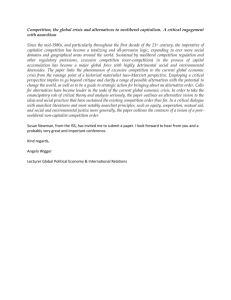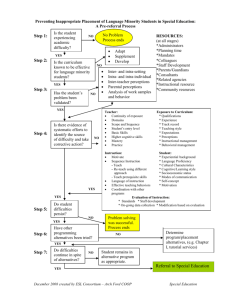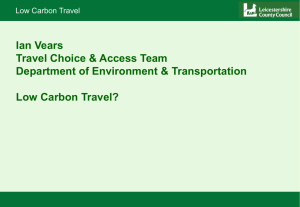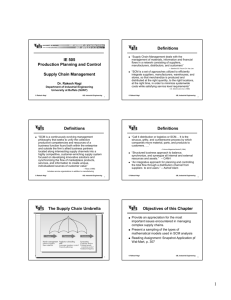October 29, 2009 SAG Meeting Summary
advertisement
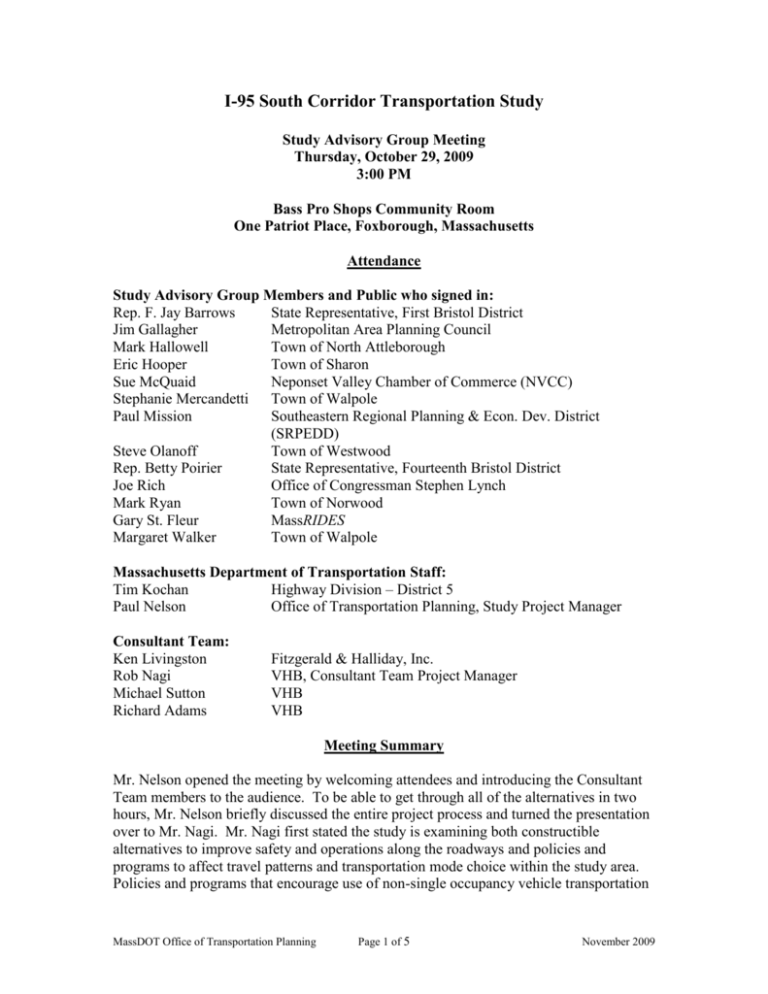
I-95 South Corridor Transportation Study Study Advisory Group Meeting Thursday, October 29, 2009 3:00 PM Bass Pro Shops Community Room One Patriot Place, Foxborough, Massachusetts Attendance Study Advisory Group Members and Public who signed in: Rep. F. Jay Barrows State Representative, First Bristol District Jim Gallagher Metropolitan Area Planning Council Mark Hallowell Town of North Attleborough Eric Hooper Town of Sharon Sue McQuaid Neponset Valley Chamber of Commerce (NVCC) Stephanie Mercandetti Town of Walpole Paul Mission Southeastern Regional Planning & Econ. Dev. District (SRPEDD) Steve Olanoff Town of Westwood Rep. Betty Poirier State Representative, Fourteenth Bristol District Joe Rich Office of Congressman Stephen Lynch Mark Ryan Town of Norwood Gary St. Fleur MassRIDES Margaret Walker Town of Walpole Massachusetts Department of Transportation Staff: Tim Kochan Highway Division – District 5 Paul Nelson Office of Transportation Planning, Study Project Manager Consultant Team: Ken Livingston Rob Nagi Michael Sutton Richard Adams Fitzgerald & Halliday, Inc. VHB, Consultant Team Project Manager VHB VHB Meeting Summary Mr. Nelson opened the meeting by welcoming attendees and introducing the Consultant Team members to the audience. To be able to get through all of the alternatives in two hours, Mr. Nelson briefly discussed the entire project process and turned the presentation over to Mr. Nagi. Mr. Nagi first stated the study is examining both constructible alternatives to improve safety and operations along the roadways and policies and programs to affect travel patterns and transportation mode choice within the study area. Policies and programs that encourage use of non-single occupancy vehicle transportation MassDOT Office of Transportation Planning Page 1 of 5 November 2009 I-95 South Corridor Transportation Study October 29, 2009 SAG Meeting modes are grouped under the term Transportation Demand Management (TDM). The study team is considering a variety of TDM improvements in the corridor including upgrades to existing services like the MBTA commuter rail network and new services or policies such as a park-and-ride network to support carpooling or new land use regulations in the study area communities. Mr. Nagi provided an overview of the TDM measures being considered and stated that more in-depth information will follow. Without any comments, Mr. Nagi began to discuss the specific alternatives developed by VHB and started with the I-95 mainline portion. Mr. Nagi explained the seven I-95 mainline alternatives and the supporting analysis. Mr. Nagi then presented the short-term and long-term suggested alternatives. The short-term alternative would bring the mainline up to meet current design standards where possible. The long-term alternative would widen the mainline to four lanes in each direction in three segments. Opposition to the recommended and suggested alternatives was raised by Steve Olanoff. Steve questioned the addition of a fourth lane and the use of breakdown lanes. Steve said that we shouldn’t be discussing either of these long-term alternatives. He said that breakdown lane use, which is a precursor to lane widening, doesn’t work and is proven. Mr. Nagi reiterated that widening the I-95 mainline to four lanes is the suggested alternative for the year 2030 if/when the traffic volumes dictate the need for them, but highlighted that there are a number of other TDM strategies that should be implemented prior to the addition of a lane along I-95. Mr. Nagi then discussed the I-95 exit 1 alternatives. Mr. Nagi briefly discussed the considered alternatives and then described the three short-term alternatives and the longterm alternative to remove the interchange. There was no opposition to any of the suggested alternatives. There was a question to clarify the figure label on the southbound off-ramp label which Mr. Nagi explained was just the label for the ramp number. Mr. Nagi then discussed the I-95 exit 2 alternatives. Mr. Nagi briefly discussed the considered alternatives and then described the two short-term alternatives and the longterm alternative to construct a partial cloverleaf interchange. Mr. Nagi described the two proposed signals to which Mr. Nelson suggested pulling the proposed signals in towards the I-95 mainline to provide more distance from the residential areas around the interchange. No comments were given on any of the exit 2 alternatives. Mr. Nagi then discussed the I-95 exit 3 alternatives. Mr. Nagi briefly discussed the considered alternatives and then described the short-term, medium-term, and long-term alternatives. No comments were given on any of the exit 3 alternatives. Mr. Nagi then discussed the I-95 exit 4 alternatives. Mr. Nagi briefly discussed the considered alternatives and then described the three short-term, medium-term, and longterm alternatives. A question was asked by State Representative Jay Barrows regarding the design speed of high speed to high speed ramp connections. Mr. Sutton responded that the design speed is usually 55 mph. No other opposition was raised. Due to the limited time remaining, Mr. Nelson asked Mr. Nagi to touch only on the suggested alternatives. MassDOT Office of Transportation Planning Page 2 of 5 November 2009 I-95 South Corridor Transportation Study October 29, 2009 SAG Meeting Mr. Nagi then discussed the I-95 exit 5 suggested alternatives. Mr. Nagi explained the signage issue in which southbound drivers actually see the exit 4 sign before exit 5. Mr. Nagi also explained the proposed park-and-ride area at the former Triboro Theater parcel west of the interchange. Mark Hallowell asked what the primary use of a park-and-ride facility. Mr. Nelson explained that this particular park-and-ride facility would be primarily used for Carpools/Vanpools and commuter busses. Mr. Nagi was asked what the timeline was for the suggested alternatives. Mr. Nagi explained the estimated timeline for short-term, medium-term, and long-term alternatives. No comments were given on any of the exit 5 alternatives. Mr. Nagi then discussed the I-95 exit 6 suggested alternatives. Mr. Nagi, before explaining the long-term and very long-term alternatives, reiterated that the timeline for these suggestions are for the year 2030 and beyond. He again placed emphasis on the global recommendations and the idea of reducing demand. No comments were given on any of the exit 6 alternatives. Mr. Nagi then discussed the I-95 exit 7 suggested alternatives. Mr. Nagi explained the safety issues at Fisher Street and the weaving movements. Mr. Nagi explained the two proposed signals that might slow down traffic on Route 140. A question was asked if the proposed traffic signals would create new safety issues. Mr. Nagi explained that removing the weaving movements and adding the signals is probably safer than the weaving movements. Mr. Nelson suggested that the proposed traffic signals only control left turn vehicles, similar to Route 9 in Framingham. Mr. Nagi, Mr. Sutton, and Mr. Nelson explained that the current layout of Route 140 near the exit 7 ramps allows for faster driving speeds. They also explained that the proposed signals may not significantly improve operations but will create a safer interchange. Mr. Nagi then discussed the I-95 exit 8 suggested alternatives. Mr. Nagi explained the two short term alternatives. No comments were given on any of the exit 8 alternatives. Mr. Nagi then discussed the I-95 exit 9 suggested alternatives. Mr. Nagi explained the existing issues with this interchange. Mr. Nagi explained the short-term alternatives and the possible locations of the park-and-ride lots. Mr. Nagi explained the very long-term alternative which would eliminate the weaving movements along Route 1. No comments were given on any of the exit 9 alternatives. Mr. Nagi then discussed the I-95 exit 10 suggested alternatives. Mr. Nagi explained the short-term alternative and long-term alternative. Mr. Nagi explained that the completion of the Coney Street interchange would result in a net reduction of traffic volume at the exit 9 interchange and the completion of the Coney Street interchange may require the bridge to be expanded which would significantly increase the cost of the alternative. Mr. Nelson stated that roundabouts instead of the proposed signals would be a cheaper alternative because the bridge may not have to be expanded. No comments were given on any of the exit 10 alternatives. MassDOT Office of Transportation Planning Page 3 of 5 November 2009 I-95 South Corridor Transportation Study October 29, 2009 SAG Meeting Mr. Nagi then discussed the I-95 exit 11 suggested alternatives. Mr. Nagi explained the issues at Wedgewood Drive and the benefits of optimizing the traffic signals. Mr. Nagi explained the long-term alternatives. State Representative Jay Barrows asked what it would take to optimize those signals now. State Rep Barrows confirmed that the ramp intersections and intersections to the east are very congested. Mr. Nagi and Mr. Sutton explained the process to update/optimize a traffic signal. Mr. Nelson stated that the I93/I-95 connection may improve this interchange and Mr. Olanoff agreed. Mr. Nelson stated the slip ramp would provide relief at exit 11 as well. Mr. Nagi then discussed the I-95 slip ramp at Dedham Street. No improvements were proposed and no comments were raised. Mr. Nagi then discussed the I-495 exit 11/12, 14, and 15 suggested short-term alternatives. No comments were raised. This concluded the presentation for the I-95 mainline, I-95 interchange, and I-495 interchange sections. Mr. Nagi asked if there were any more questions or comments regarding these sections. Mr. Nagi then proceeded to the Route 1 alternatives presentation. Mr. Nagi then discussed the short-term alternatives at the intersection of Route 1 and Route 123. No comments were raised. Mr. Nagi then discussed the Route 1 at Route 1A/Elmwood Street alternatives. Mr. Nagi explained that traffic counts were obtained at the intersection of Route 1A and Whiting Street which helped to analyze the long-term alternatives. No comments were raised. Mr. Nagi then discussed the Route 1 at East Street / Main Street alternatives. Mr. Nagi explained the five suggested short-term alternatives. No comments were raised. Mr. Nagi then discussed the Route 1 at Route 27 / High Plain Street alternatives. Mr. Nagi explained the five suggested short-term alternatives. No comments were raised. Mr. Nagi then discussed the Route 1 at Coney Street alternatives. Mr. Nagi explained the four suggested short-term alternatives and long-term alternative. No comments were raised. Mr. Nagi then discussed the Route 1 at Dean Street alternatives. Mr. Nagi explained both short-term alternatives. Ms. Sue McQuaid said that this intersection is poorly designed and very dangerous. Ms. McQuaid said that signage is poor especially in the southbound direction on Dean Street. She also stated that the access and egress to the Ocean State Job Lot parking area is dangerous. Mr. Nagi explained that the short-term alternatives address some of the safety deficiencies. Mr. Nagi then discussed the Route 1 at Everett Street / University Avenue alternatives. Mr. Tim Kochan from the MassHighway District 5 stated that there is a need for improvement at this intersection. Mr. Kochan said there is a Proejct Need Form is soon to follow. Capacity needs to be added to Everett Street, possible dual left turn lanes, MassDOT Office of Transportation Planning Page 4 of 5 November 2009 I-95 South Corridor Transportation Study October 29, 2009 SAG Meeting reconstruction of the median and street light improvements. A number of consultants including Tetra Tech, Fort Hill, and Jack Gillen have analyzed this intersection with three Route 1 through lanes which yielded a LOS of C. Grade separating the northbound lanes of Route 1 was then discussed. Mr. Olanoff did not think the design of the grade separation done solely for the restaurants should dictate the entire design. Mr. Nagi then discussed the Route 1 at Elm Street alternatives. Mr. Nagi explained the short-term and medium-term alternatives. No comments were raised. Mr. Nagi then discussed the Route 1 at Washington Street alternatives. Mr. Nagi explained the short-term and medium term alternatives. No comments were raised. This concluded the specific alternatives portion of the presentation. Mr. Nagi asked if there were any more questions or comments. Mr. Olanoff wanted the team to look into more alternatives for the intersections of Route 1 at Eastern Avenue and Route 1 at Washington Street. There were no other comments or questions and Mr. Nagi turned the meeting over to Mr. Nelson. Mr. Nelson stated that the public informational meetings will likely occur in early or mid December. Mr. Nelson stated that he would like to have the project completed before the end of the year. Mr. Nelson asked the advisory group to think of ways to increase attendance to the public meetings. Prior to the public informational meetings, MassDOT will be scheduling community outreach meetings with officials from the cities and towns in the study area. Action Items: 1. Look into the three Route 1 at Everett Street studies 2. Schedule the public informational meetings 3. Schedule community outreach meetings with town officials 4. Develop strategies to encourage attendance at public informational meetings MassDOT Office of Transportation Planning Page 5 of 5 November 2009





